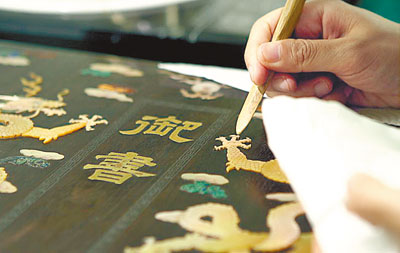 EVEN though people are still talking about the amazingly made documentary series “Bite of China,” a new three-episode documentary about the Palace Museum in Beijing has recently entered the spotlight. “Masters in Forbidden City” records the work and lives of restoration experts at the museum and showcases the process of restoring relics such as ancient calligraphy, paintings, bronze works, clocks, pottery, wood works, and embroidery. So far, the documentary has had more than 700,000 views on the Internet and has been rated as high as 9.5 at douban.com, a popular movie and book review website in China. “This documentary has shown us so many beautiful relics and beautiful people. I was impressed by our ancestors’ artistic achievements and was moved by the experts’ dedication and devotion. Three episodes were not enough, and we want to see more stories and people like them,” said a netizen who goes by the username “Tuturen” from Tianjin at douban.com. Directed by the award-winning Chinese documentary director Xiao Han, work on the documentary began five years ago. “We started this documentary, including field investigations, more than five years ago. However, because it is the Forbidden City and the Palace Museum, we had to film at designated times. Last year was the 90th anniversary of the Palace Museum, so we were allowed to film there,” said Xiao, an associate professor at Zhejiang University of Technology in Zhejiang Province. Xiao has directed other popular documentaries, including “Himalaya, Ladder to Paradise.” Applying to film within the Palace Museum was not difficult, but the process was complicated and took a long time, which became an issue for the team. “Some special applications were also a problem for us. For example, we wanted to shoot the starry sky inside the Palace Museum, so we applied for the right to film at night. However, the whole week had cloudy nights, so we had to apply again and again in order to get the best views,” Xiao said. Even so, Xiao did not see this as a big issue. “The most difficult part for us was getting the chance to film the really good collections. This can only happen by chance,” he said. In fact, there are many documentaries focusing on historical and cultural relic restorations in China, so why is this one getting so much attention? “Many people thought this topic might be boring, but it is not. What makes ours different from the rest was our angle. This documentary focuses more on the people that restore the relics, not the relics themselves. This is very important. Viewers fell in love with this documentary because they fell in love with the people in it,” Xiao said. Because of this angle, there are many scenes in the documentary that show the experts’ ordinary daily lives at the museum, such as picking fruit, playing with cats and planting trees. “We spent more than four months working and living with these experts. We went to work with them, went out for dinner with them and even went on business trips with them. By the end, our team had become a part of their work, and we still hang out with them a lot,” Xiao said. Most documentaries about relic restoration do not show the actual process of restoring ancient items. Some viewers guessed that this might be because their skills were “secret” and could not be revealed to the public. However, Xiao denied this. “We did not focus too much on the actual work because demonstrating the skill and process was too easy. A lot of the skills and techniques can be summarized in only one sentence, but it may take a person a lifetime to master them,” he said. “For example, for the Bronze team, it may take you months to polish a small item. There is nothing new in the process, but the skill level requires years of practice. Nobody can manage that after one training course. Therefore, we thought there was no need to focus too much on the skills and techniques because we were making a documentary, not a training program.” After filming with these experts, Xiao was moved by their “craftsman’s spirit” and wanted to pass on this spirit to modern Chinese viewers. “There are different levels of the ‘craftsman’s spirit.’ The most important thing is dedication and devotion. Devoting yourself to only one thing in your entire life is something so amazing, but young people today find that hard to imagine. A lot of them change their jobs very frequently, so this is why the documentary hit so many viewers’ hearts. Today, it is hard to slowly, quietly and calmly perfect one skill. This is what moves the audience,” Xiao said. Because the documentary has resonated with young viewers, Xiao plans to release a shorter version for online broadcasting. Each episode will be about five minutes and each expert featured in the documentary will get their own episode. “The documentary also has wide appeal for the international market, so we will also release an international version so that people around the world will have a chance to see it,” Xiao said. (Wang Yuanyuan) | 
